Chapter 6 and 7 Anatomy JCCC
1/153
There's no tags or description
Looks like no tags are added yet.
Name | Mastery | Learn | Test | Matching | Spaced |
|---|
No study sessions yet.
154 Terms
What are the main components of the skeletal system?
Bones, cartilages, ligaments, and other supportive connective tissues.

What type of connective tissue is cartilage?
Semirigid connective tissue that is weaker than bone but more flexible and resilient.
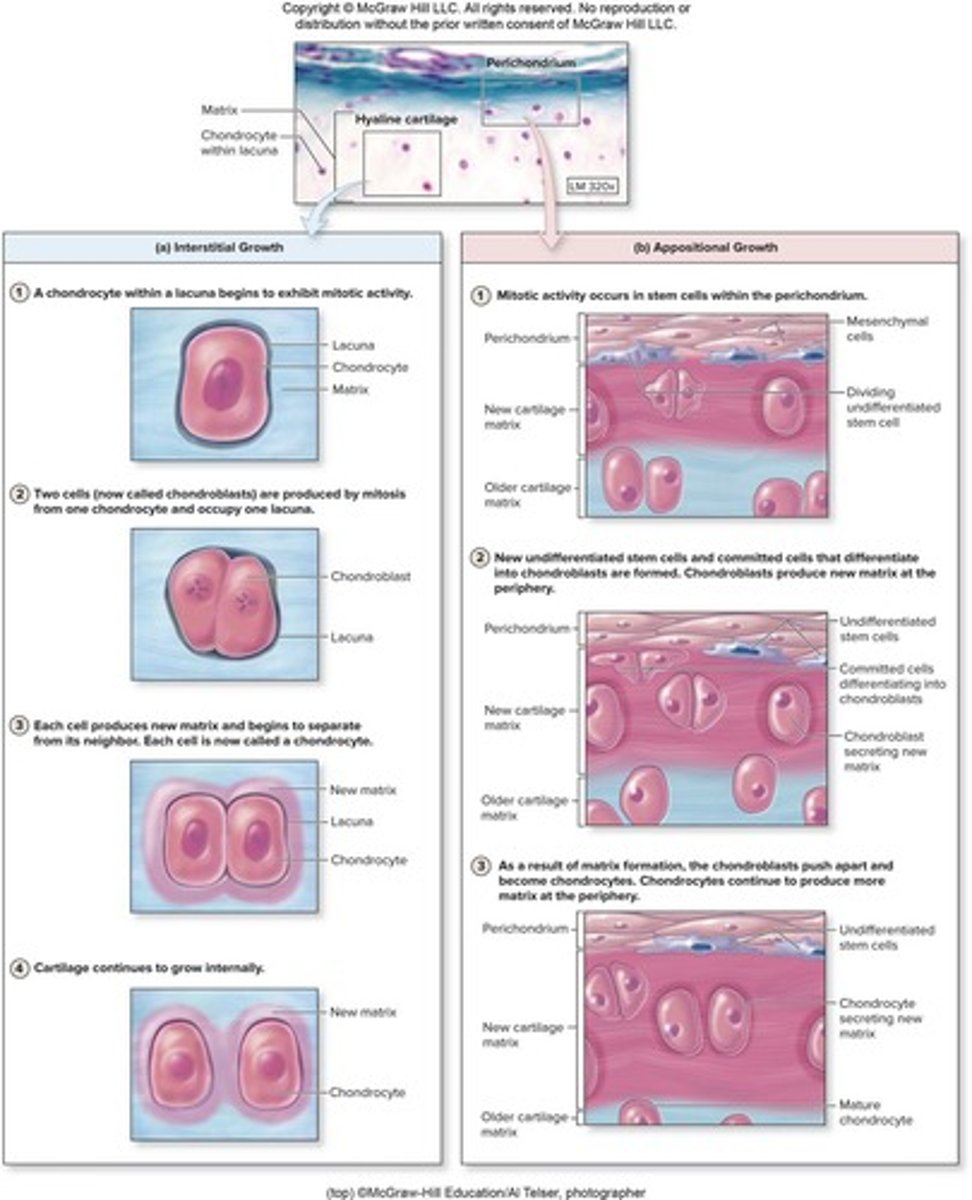
What are the two main types of cells found in mature cartilage?
Chondroblasts, which produce the matrix, and chondrocytes, which are surrounded by the matrix.
What is the primary function of cartilage?
Supporting soft tissues, providing gliding surfaces at joints, and serving as a model for bone formation.
What are the two types of cartilage growth?
Interstitial growth (from within) and appositional growth (along the periphery).
What are the four major steps of interstitial growth in cartilage?
1. Mitosis of chondrocytes in lacunae. 2. Formation of two chondroblasts per lacuna. 3. Synthesis and secretion of new matrix. 4. Growth results in larger cartilage with newest matrix on the inside.
What are the three major steps of appositional growth in cartilage?
1. Mitosis of stem cells deep to perichondrium. 2. Stem cells become chondroblasts at the periphery. 3. Chondroblasts produce matrix and become chondrocytes in lacunae.
What are the primary functions of bone?
Support and protection of organs, movement, hemopoiesis (blood cell production), and storage of minerals and energy reserves.

What are the four classifications of bones by shape?
Long bones, short bones, flat bones, and irregular bones.
What characterizes long bones?
They have greater length than width, such as upper and lower limb bones.
What characterizes short bones?
They have nearly equal length and width, such as carpals and tarsals.
What are flat bones?
Bones with thin, flat surfaces, such as the roof of the skull and the sternum.
What are irregular bones?
Bones with complex shapes, such as vertebrae.
What is the diaphysis of a long bone?
The elongated, cylindrical shaft.
What are the epiphyses of a long bone?
Knobby, enlarged regions at each end, including proximal and distal epiphyses.
What is the metaphysis in a long bone?
The region between the diaphysis and epiphysis that contains the epiphyseal plate.
What is the role of articular cartilage?
It covers the epiphysis, reducing friction and absorbing shock in movable joints.
What is the medullary cavity?
A hollow, cylindrical space in the diaphysis that contains yellow bone marrow in adults.
What is the endosteum?
A membrane that covers most internal surfaces of bones and contains osteoprogenitor cells, osteoblasts, and osteoclasts.

What is the periosteum?
A dense irregular connective tissue covering the external surfaces of bones, except where articular cartilage is present.
What are osteoprogenitor cells?
Mesenchymal stem cells located in the endosteum and periosteum that can produce more stem cells or osteoblasts.
What is the function of osteoblasts?
To form bone matrix by secreting organic osteoid.
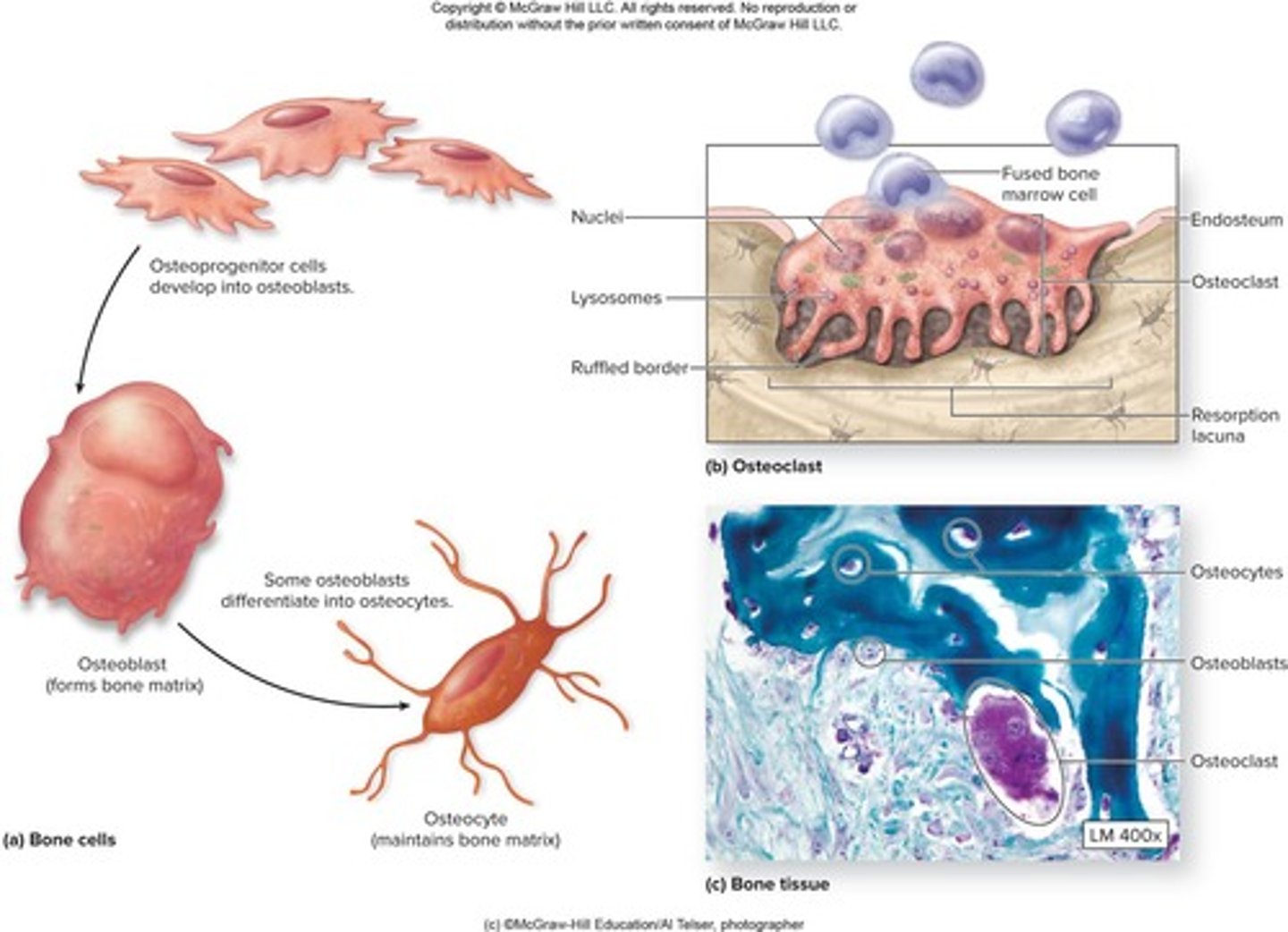
What role do osteocytes play in bone?
They reside in lacunae, maintain the matrix, and detect mechanical stress on the bone.
What are osteoclasts?
Large, multinuclear cells that dissolve bone matrix, releasing calcium through a process called osteolysis.
What are the organic components of the bone matrix?
Cells, collagen fibers for tensile strength, and ground substance.
What are the inorganic components of the bone matrix?
Primarily hydroxyapatite, which includes calcium phosphate and calcium hydroxide, providing compressional strength.
What distinguishes compact bone from spongy bone?
Compact bone is solid and dense, while spongy bone has an open lattice structure called trabeculae.
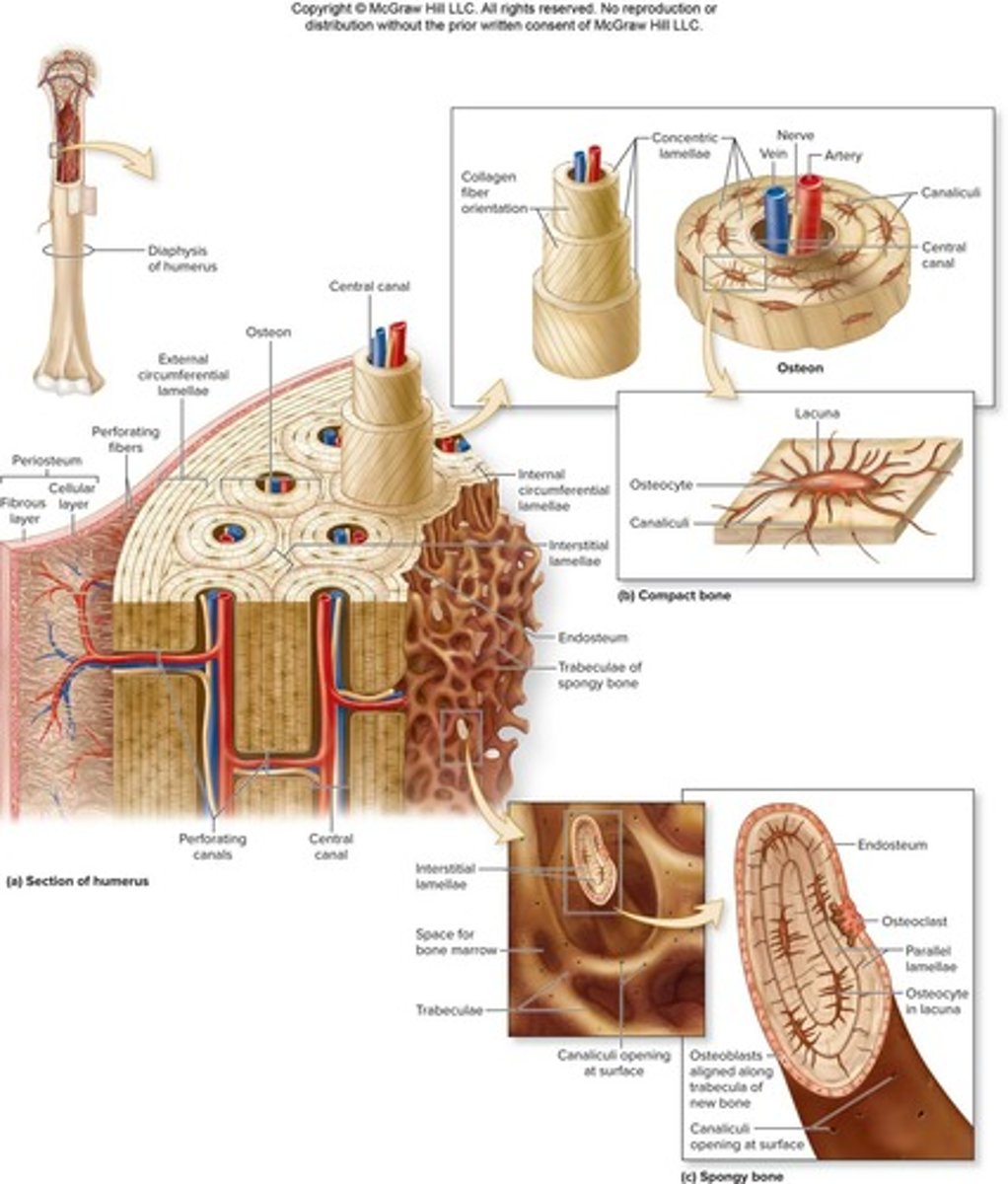
What is an osteon?
The basic unit of compact bone, also known as a Haversian system, consisting of cylindrical structures that run parallel to the diaphysis.
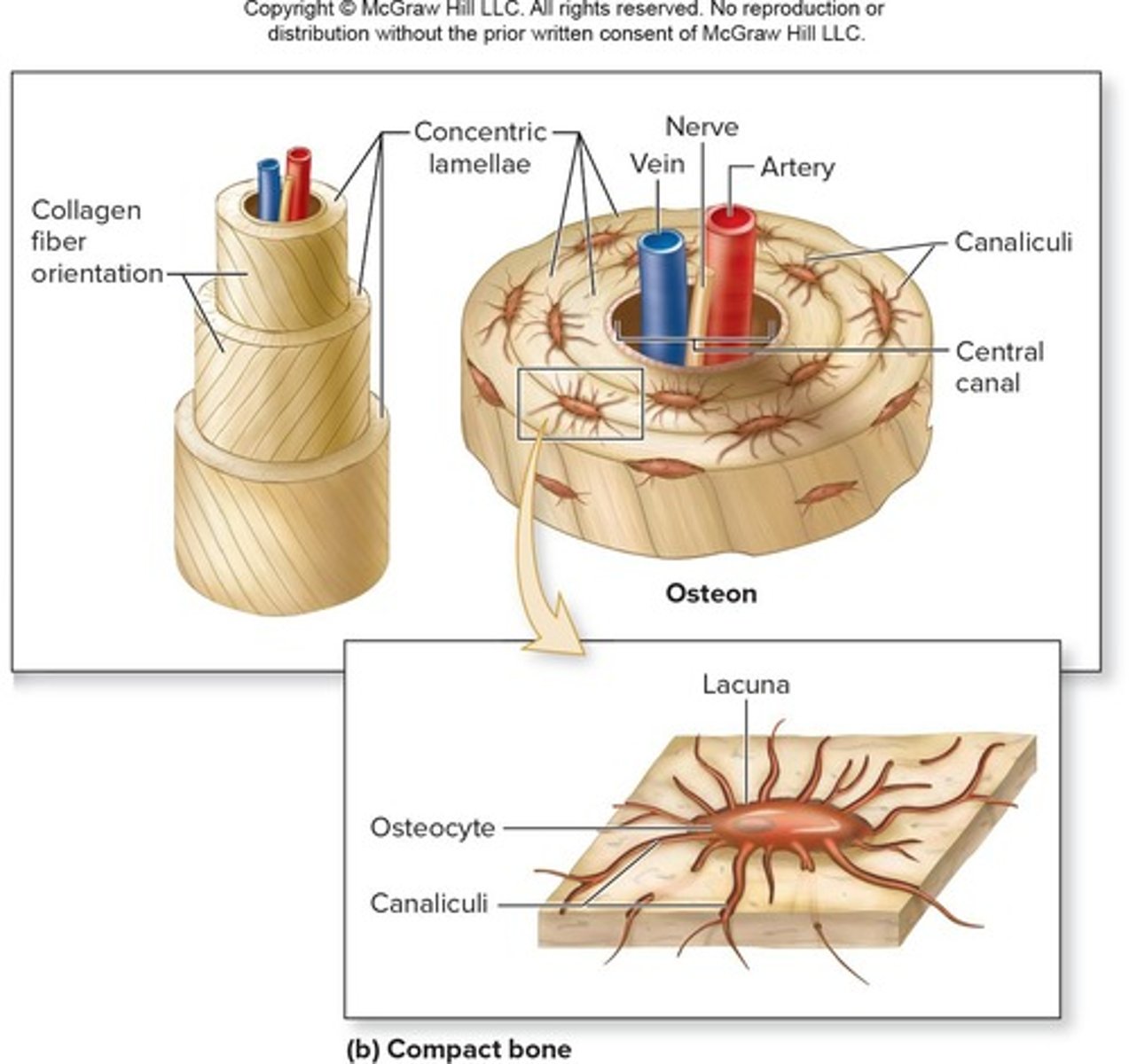
What are the components of an osteon?
Central canal, concentric lamellae, osteocytes in lacunae, canaliculi, perforating canals, circumferential lamellae, and interstitial lamellae.
What is the function of trabeculae in spongy bone?
They provide resistance to stresses applied in many directions.
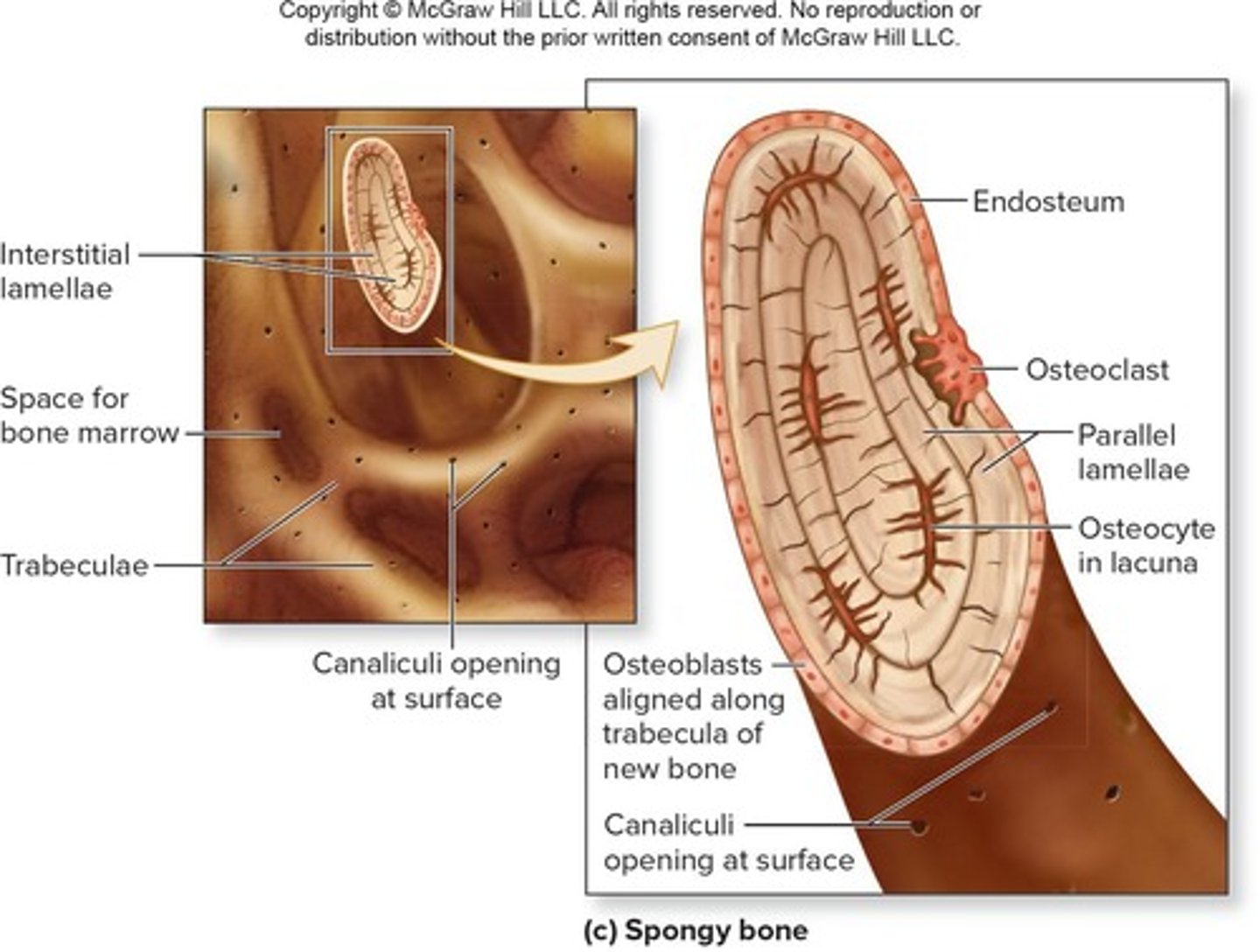
What is ossification?
Ossification (osteogenesis) is the formation and development of bone connective tissue.
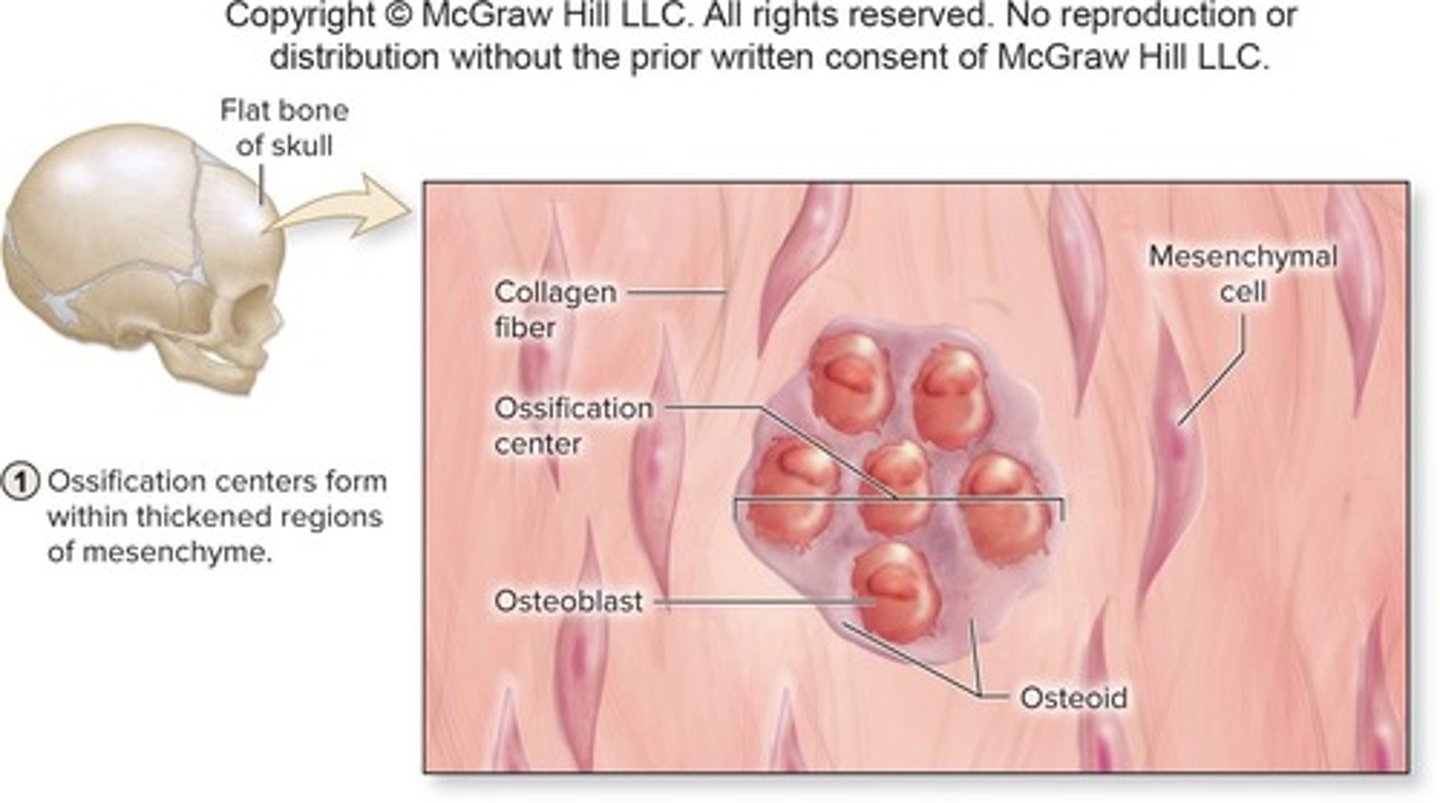
What are the two patterns of ossification?
The two patterns of ossification are intramembranous ossification and endochondral ossification.
What does intramembranous ossification produce?
Intramembranous ossification produces flat bones of the skull, some facial bones, the mandible, and the central portion of the clavicle.
What is the starting material for endochondral ossification?
Endochondral ossification begins with a hyaline cartilage model.
What does endochondral ossification produce?
Endochondral ossification produces most of the rest of the bones in the body, such as the upper and lower limb bones.
What is the first step in intramembranous ossification?
The first step is the formation of ossification centers within thickened regions of mesenchyme.
What occurs during the second step of intramembranous ossification?
During the second step, osteoid undergoes calcification.
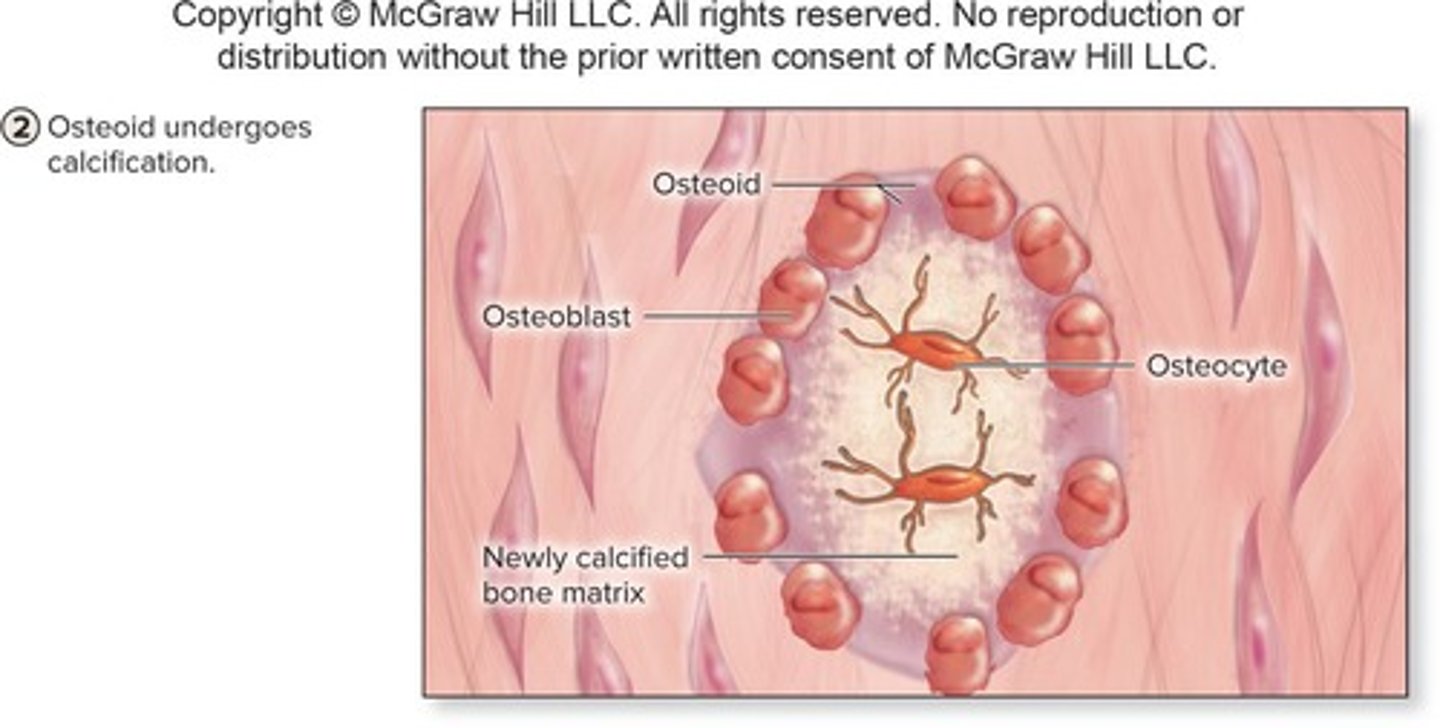
What forms during the third step of intramembranous ossification?
Woven bone and surrounding periosteum form during the third step.
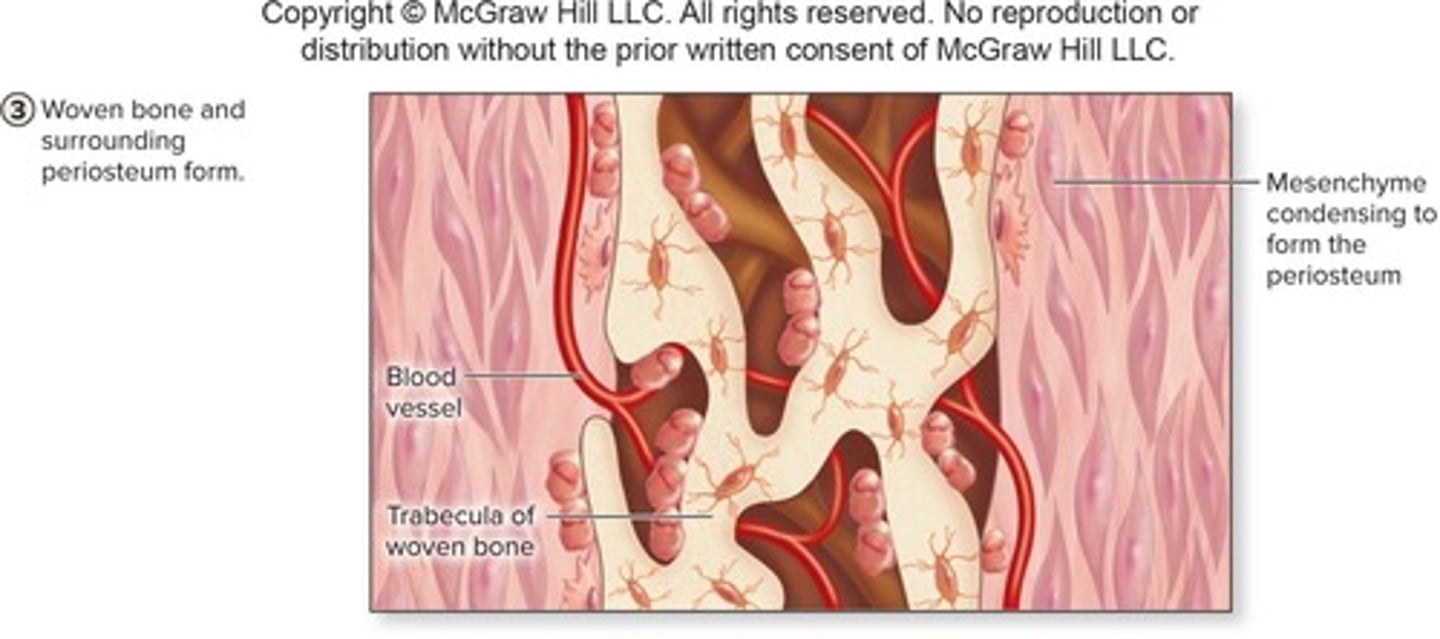
What happens in the fourth step of intramembranous ossification?
Lamellar bone replaces woven bone, as compact bone and spongy bone form.
What is the first step in endochondral ossification?
The first step is the development of the fetal hyaline cartilage model.
What forms around the cartilage during endochondral ossification?
A periosteal bone collar forms around the cartilage.
Where does the primary ossification center form in endochondral ossification?
The primary ossification center forms in the diaphysis.
What is the role of secondary ossification centers in endochondral ossification?
Secondary ossification centers form in the epiphyses.
What remains as bone replaces cartilage in endochondral ossification?
Bone replaces cartilage except for the articular cartilage and epiphyseal plates.
What happens to epiphyseal plates as they mature?
They ossify and form epiphyseal lines.
What is the epiphyseal plate composed of?
A layer of hyaline cartilage at the boundary of the epiphysis and diaphysis.
What is the primary function of the epiphyseal plate?
It is the site of interstitial growth.
How many distinct microscopic zones are in the epiphyseal plate?
Five distinct microscopic zones.
What are the five zones of the epiphyseal plate?
Zone of resting cartilage, zone of proliferating cartilage, zone of hypertrophic cartilage, zone of calcified cartilage, zone of ossification.
Describe the zone of resting cartilage.
It is farthest from the medullary cavity and nearest the epiphysis, containing small chondrocytes in hyaline cartilage.
What occurs in the zone of proliferating cartilage?
Larger chondrocytes undergo rapid mitotic cell division and are aligned like stacks of coins.
What happens in the zone of hypertrophic cartilage?
Chondrocytes cease dividing and become enlarged.
What occurs in the zone of calcified cartilage?
Deposited minerals kill the chondrocytes and make the matrix opaque.
What happens in the zone of ossification?
Walls between lacunae break down, forming channels invaded by capillaries and osteoprogenitor cells.
What is interstitial growth in bones?
A long bone's growth in length that occurs in the epiphyseal plate.
What is appositional growth in bones?
Growth in a bone's diameter that occurs in the periosteum.
How do osteoblasts and osteoclasts contribute to appositional growth?
Osteoblasts lay down external circumferential lamellae, while osteoclasts enlarge the medullary cavity from within the bone.
What is bone remodeling?
The continual production of new bone and resorption of old bone.
Why is bone remodeling important?
It helps maintain calcium and phosphate levels.
What stimulates bone remodeling?
Stress on the bones.
How is blood supplied to a typical long bone?
Through four major sets of blood vessels: nutrient artery/vein, metaphyseal arteries/veins, epiphyseal arteries/veins, and periosteal arteries/veins.

What does the nutrient artery supply?
It supplies the diaphysis of a long bone.
What do metaphyseal arteries supply?
They supply the diaphyseal side of the epiphyseal plate.
What do epiphyseal arteries supply?
They supply the epiphyses.
What do periosteal arteries supply?
They supply blood to the external circumferential lamellae and superficial osteons.
What accompanies blood vessels through the nutrient foramen in bones?
Nerves.
What are the three key factors that depend on growth, maintenance, and repair of bones?
Hormones, vitamins, and exercise.
How do hormones affect bone growth?
Hormones regulate osteoblast and osteoclast activity and calcium levels.
Which hormones stimulate cartilage growth at the epiphyseal plate?
Growth hormone and insulin-like growth factor (IGF).
What is the role of thyroid hormone in bone growth?
Thyroid hormone stimulates the metabolic rate of osteoblasts, thereby stimulating bone growth.
What are the opposing effects of calcitonin and parathyroid hormone on calcium levels?
Calcitonin promotes calcium deposition from blood to bone and inhibits osteoclast activity, while parathyroid hormone stimulates osteoclasts to resorb bone and increase calcium levels in the blood.
How do sex hormones affect bone growth?
Sex hormones (estrogen and testosterone) accelerate bone growth significantly during puberty.
What effect do abnormally high glucocorticoid levels have on bones?
They lead to a loss of bone mass.
Which vitamins are essential for normal bone growth and maintenance?
Vitamin A, Vitamin C, and Vitamin D.
What is the function of Vitamin A in bone health?
Vitamin A activates osteoblasts.
Why is Vitamin C important for bones?
Vitamin C is required for collagen synthesis.
How does Vitamin D contribute to bone formation?
Vitamin D stimulates calcium absorption from the gastrointestinal tract into the blood.
What effect does mechanical stress have on bone density?
Mechanical stress stimulates an increase in bone density by increasing osteoblast activity.
How do the bones of athletes compare to those of non-athletes?
Bones of athletes become thicker and stronger due to repetitive and stressful exercise.
What happens to bones with age and how can this be mitigated?
Bones lose mass with age, but this can be slowed or reversed with weight-bearing exercise.
How are fractures classified based on their cause?
Fractures can be classified as stress, traumatic, or pathologic.
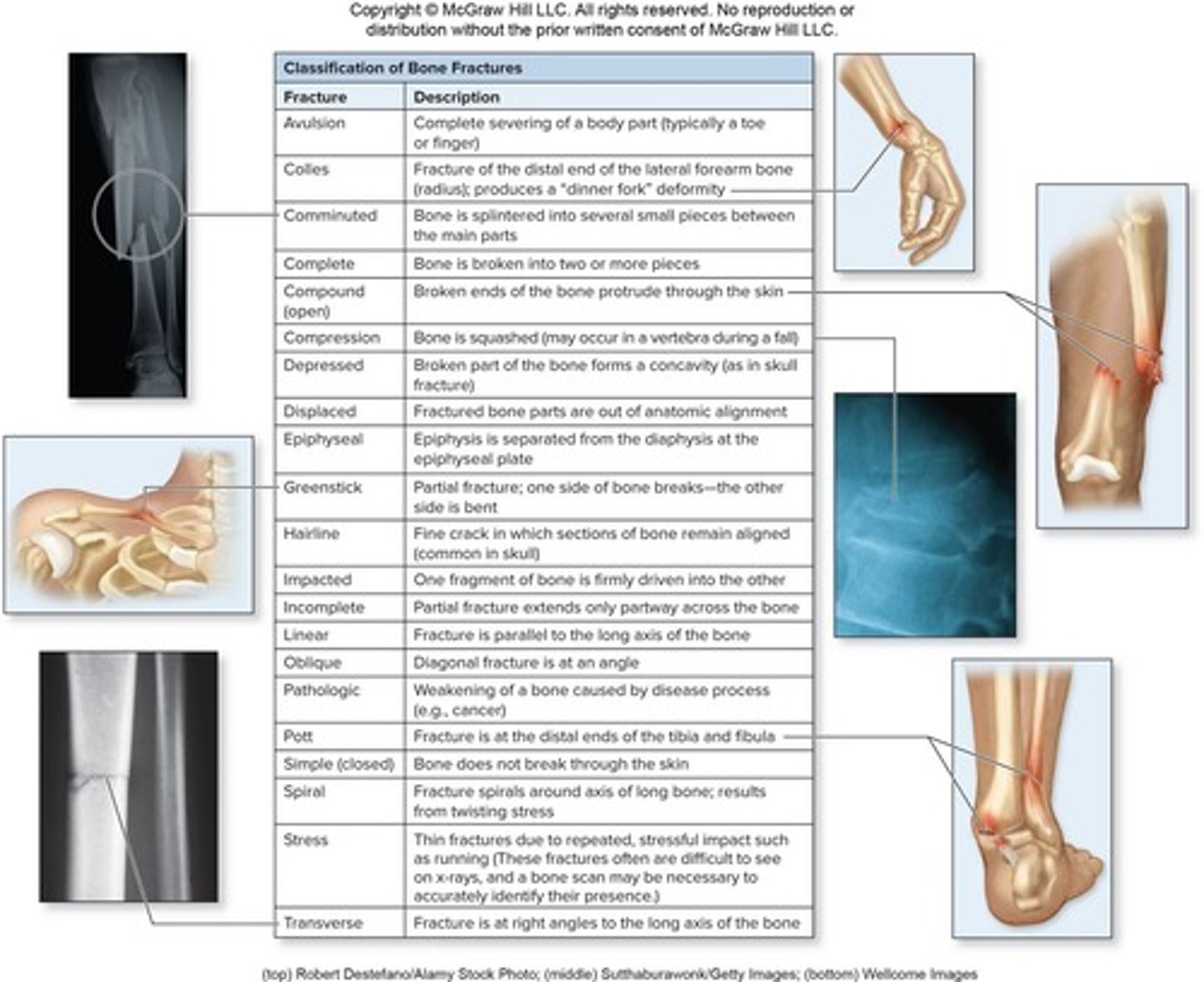
What is a stress fracture?
A thin break due to increased activity and repetitive loads.
What characterizes a traumatic fracture?
A traumatic fracture occurs due to excess stress to the bone.
What is a pathologic fracture?
A fracture that occurs in bone weakened by disease.
How are fractures classified based on soft tissue damage?
Fractures can be classified as simple (does not penetrate the skin) or compound (penetrates the skin).
What are the steps involved in fracture repair?
1. A fracture hematoma forms, 2. A fibrocartilaginous (soft) callus forms, 3. A bony (hard) callus forms.
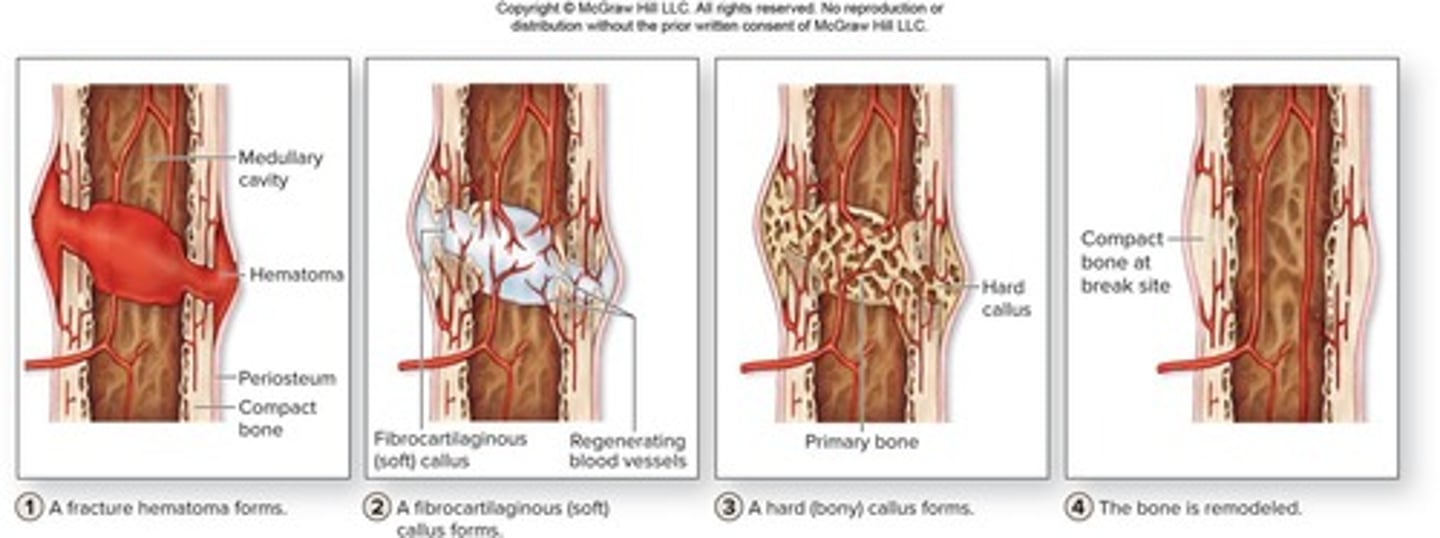
What are bone markings and their significance?
Bone markings are surface features that characterize bones, indicating sites of articulation, passage of vessels and nerves, and attachment of tendons and ligaments.
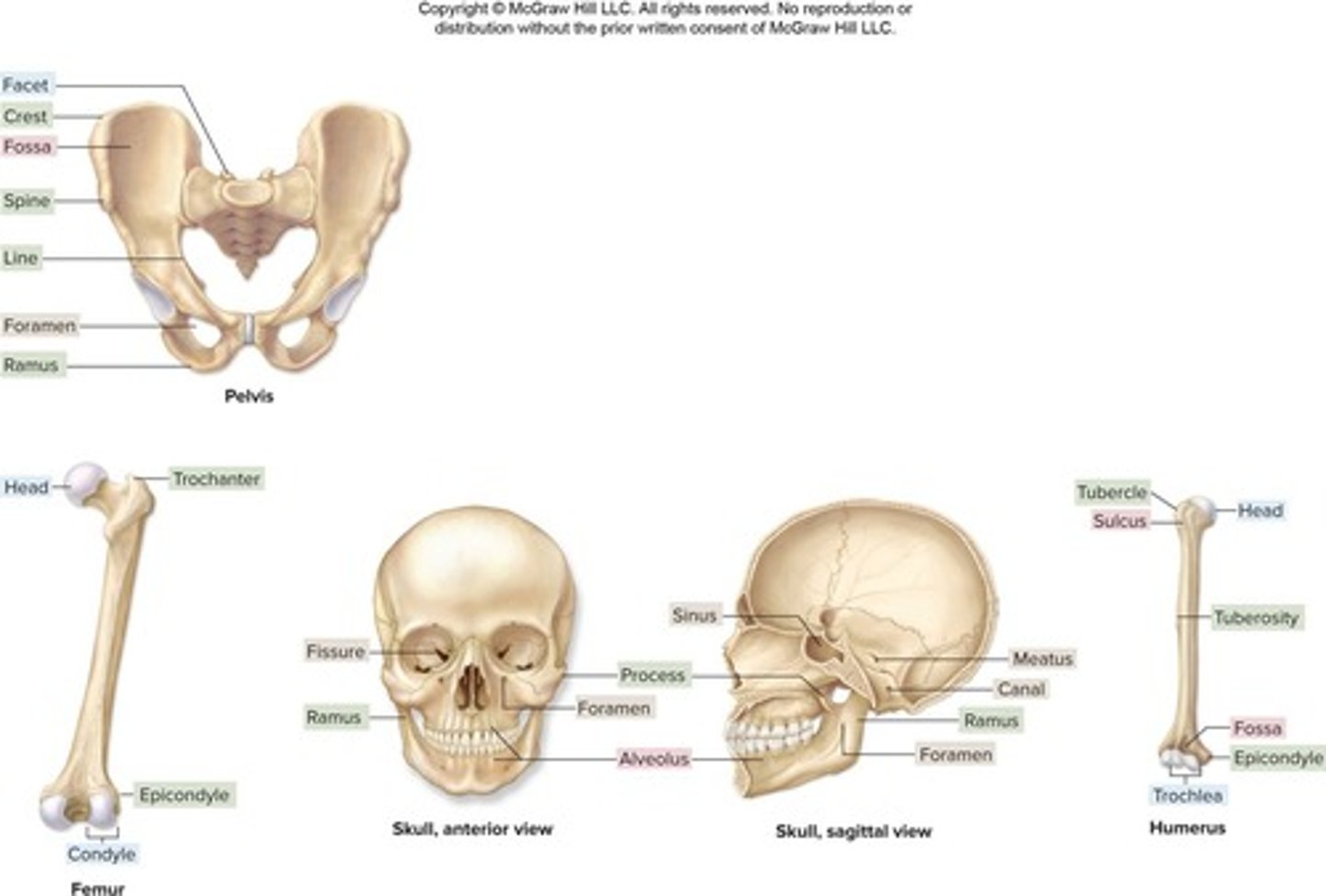
What is a condyle?
A condyle is a large, smooth, rounded oval structure that serves as an articulating surface.
What is a facet?
A facet is a small, flat, shallow surface on a bone.
What defines a head in bone anatomy?
A head is a prominent, rounded epiphysis.
What is a trochlea?
A trochlea is a smooth, grooved, pulley-like process.
What is an alveolus in bone structure?
An alveolus (pl., alveoli) is a deep pit or socket in the maxillae or mandible.
What is a fossa?
A fossa (pl., fossae) is a flattened or shallow depression in a bone.
What is a sulcus?
A sulcus is a narrow groove found in bone.
What is a crest in bone anatomy?
A crest is a narrow, prominent, ridge-like projection.
What is an epicondyle?
An epicondyle is a projection adjacent to a condyle.
What is a line in bone structure?
A line is a low ridge on a bone.
What is a ramus?
A ramus (pl., rami) is an angular extension of a bone relative to the rest of the structure.
What is a spine in bone anatomy?
A spine is a pointed, slender process.
What is a trochanter?
A trochanter is a massive, rough projection found only on the femur.